Introduction
Kanban, a prominent fixture in the Lean management toolkit, is a visual workflow management method that aims to maximize efficiency and minimize waste. Translated from Japanese, “Kanban” simply means “signboard” or “billboard”. In the context of Lean management, it represents a method for managing work as it moves through a process.
History and Development
Originating in the late 1940s, Kanban was developed by Toyota engineer Taiichi Ohno as a simple planning system aimed at controlling and managing work and inventory at every stage of production optimally. The system’s inspiration was drawn from supermarkets’ stocking methods, which restock goods based on what the customer actually takes rather than the supplier’s push.
Key Principles
Kanban is built on four primary principles:
- Visualize Work: Using cards and boards to map out tasks and workflows.
- Limit Work in Progress (WIP): Controlling the flow of work to prevent overproduction.
- Focus on Flow: Optimizing the work process to ensure smooth transitions between stages.
- Continuous Improvement: Regularly reviewing and improving the workflow.
When to Use the Tool
Kanban is best used when there is a need to streamline workflows in a visual manner. It is especially effective in environments where work can be broken down into individual tasks that move through various stages, such as software development, content creation, and manufacturing.

How It Works
Implementing Kanban in a supermarket setting involves several key steps to ensure efficient inventory management and a smooth workflow. While originally devised for manufacturing, the adaptability of Kanban makes it highly effective in diverse contexts like retail, especially in environments where inventory management is crucial. Here’s a detailed breakdown of how Kanban operates in a supermarket scenario.
1. Visualize the Workflow:
Begin by comprehensively mapping out the entire workflow of your supermarket, from receiving goods to stocking shelves and serving customers. This visualization exercise serves multiple purposes: it highlights the sequence of tasks, identifies potential bottlenecks, and exposes areas of inefficiency or waste. By having a clear visual representation of the workflow, it becomes easier to understand the entire process and identify opportunities for improvement.
2. Identify Inventory Items:
Determine which items are crucial for your supermarket’s operations. These could include perishable goods, high-demand products, or items with fluctuating popularity. Understanding the importance and demand patterns of each inventory item is essential for setting up an effective Kanban system
3. Set Inventory Levels:
Establish maximum and minimum inventory levels for each item based on various factors such as demand variability, lead times, and storage capacity. This step ensures that you maintain sufficient stock to meet customer demand without overstocking, thus minimizing waste and inventory holding costs.
4. Implement Kanban Cards:
Create Kanban cards for each inventory item, detailing information such as item name, reorder quantity, and location. These cards act as visual signals that indicate when it’s time to replenish inventory. When the stock of a particular item reaches the predetermined minimum threshold, the corresponding Kanban card is removed, signaling the need for replenishment.
5. Place Kanban Signals:
Position Kanban cards at the designated storage locations for each inventory item. As products are taken from the shelves by customers, the corresponding Kanban cards are removed and placed in a designated area for replenishment. This visual cue triggers the replenishment process, ensuring that inventory is restocked promptly to meet customer demand.
6. Replenish Inventory:
As Kanban cards accumulate in the replenishment area, initiate the procurement or production of the necessary items to replenish stock. By replenishing inventory only when needed, the Kanban system helps minimize excess inventory and reduces the risk of stockouts, thereby optimizing inventory management and enhancing operational efficiency.
7. Continuous Improvement:
Regularly review and refine the Kanban system based on feedback from employees, changes in customer demand, and improvements in processes. Continuously optimizing the system leads to further efficiencies and cost savings over time. This iterative approach to improvement aligns with the fundamental principles of Lean management, fostering a culture of continuous improvement within the organization.
By following these steps, supermarkets can effectively implement Kanban lean principles to optimize inventory management, reduce waste, and improve overall operational efficiency. Kanban serves as a powerful tool for streamlining workflows, enhancing visibility, and facilitating just-in-time inventory management, ultimately enabling supermarkets to meet customer demand more effectively while minimizing operational costs.
Benefits
The benefits of Kanban include increased productivity, enhanced efficiency, and the ability to identify bottlenecks in real-time. By visualizing the workflow, teams can collaborate more effectively and adapt quickly to changes.
Supplier-Process Optimization
In the supplier-process phase, Kanban acts as a signaling system, indicating when materials are needed. Through Kanban cards or digital systems, suppliers receive timely requests, reducing lead times and minimizing inventory holding costs. This streamlined communication fosters stronger partnerships and ensures a steady flow of materials.
Customer-Process Enhancement
For customer-processes, Kanban ensures timely delivery of products while maintaining quality standards. By visualizing workflow stages, teams can identify bottlenecks and allocate resources efficiently, meeting customer demands promptly. With Kanban, customer satisfaction increases as orders are fulfilled reliably and on time.
Common Mistakes and Pitfalls
Common mistakes in implementing Kanban include overcomplicating the board, failing to limit WIP, neglecting the review process, and not involving the entire team in the Kanban process. These can lead to reduced effectiveness and team friction.
Tips for Success
Successful Kanban implementation involves regular team meetings to discuss the board and progress, a commitment to limiting WIP, and a culture of continuous improvement. Flexibility and team buy-in are crucial to adapting Kanban to your unique workflow.
Integration With Other Lean Tools
Kanban integrates seamlessly with other Lean tools such as 5S for workspace organization, Value Stream Mapping for identifying waste, and Kaizen for continuous improvement.

FAQs
Can Kanban be used for non-manufacturing tasks?
Absolutely. Kanban is highly adaptable and can be used for a wide range of tasks, including project management, software development, and service-related work.
How do we determine the WIP limits?
WIP limits are typically set based on capacity and historical performance. Start with conservative numbers and adjust as you gather performance data
How does Kanban differ from Scrum?
While both are Agile methodologies, Kanban focuses on visualizing workflow and limiting WIP without prescribed roles or iterations, whereas Scrum is structured around time-boxed iterations called sprints.
Is a digital Kanban board better than a physical one?
It depends on team preference and work environment. Digital boards offer remote access and integrations with other tools, while physical boards provide a tangible, often more collaborative experience.
How often should the Kanban board be updated?
The Kanban board should be updated in real-time as tasks progress. Daily stand-up meetings can be used to review and make necessary adjustments.
References and Further Reading
- “Kanban: Successful Evolutionary Change for Your Technology Business” by David J. Anderson.
- “Kanban from the Inside” by Mike Burrows.
- “Lean from the Trenches: Managing Large-Scale Projects with Kanban” by Henrik Kniberg.
In summary, Kanban is a versatile tool that, when correctly implemented, can significantly enhance the efficiency of a process. By visually managing workflow, limiting WIP, and fostering a culture of continuous improvement, organizations can realize substantial productivity gains. The key to success with Kanban lies in its simplicity and adaptability, making it a favorite among Lean practitioners across various industries.

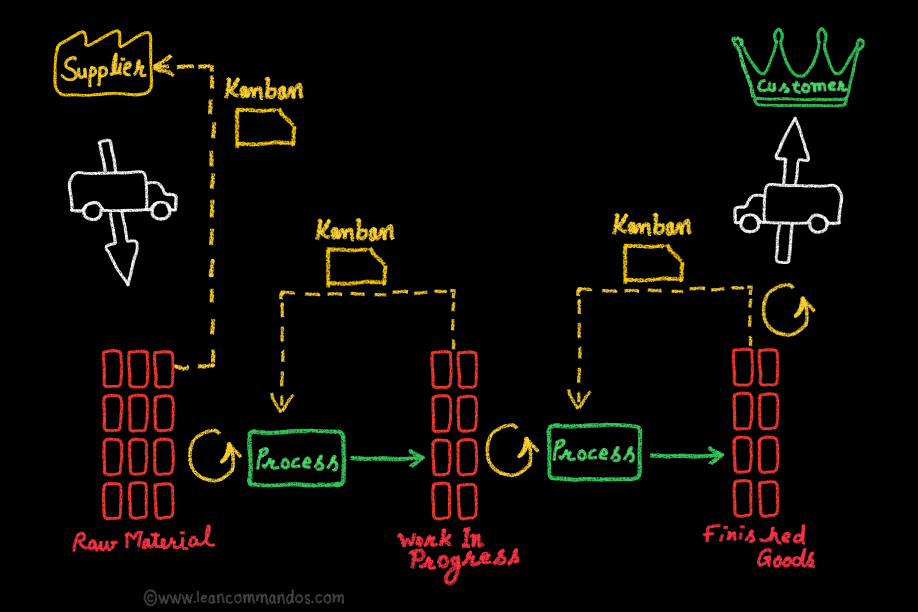
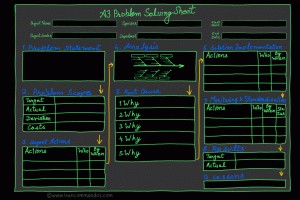
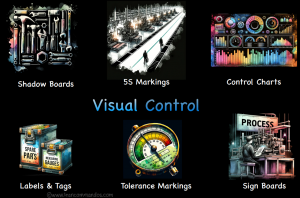

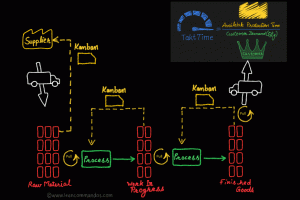
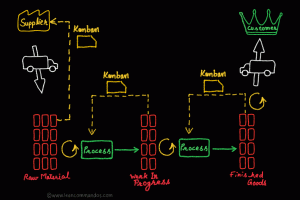

7 Responses
I’ve read several excellent stuff here. Certainly worth bookmarking for revisiting. I surprise how much effort you put to create one of these excellent informative website.
With every little thing which seems to be building within this particular subject matter, all your points of view are very refreshing. Nonetheless, I appologize, because I do not give credence to your entire idea, all be it stimulating none the less. It appears to everyone that your commentary are generally not totally justified and in fact you are generally yourself not even totally confident of your argument. In any case I did appreciate reading it.
This blog is definitely rather handy since I’m at the moment creating an internet floral website – although I am only starting out therefore it’s really fairly small, nothing like this site. Can link to a few of the posts here as they are quite. Thanks much. Zoey Olsen
It’s perfect time to make some plans for the long run and it is time to be happy. I have read this submit and if I may just I wish to suggest you some interesting issues or tips. Perhaps you could write next articles regarding this article. I desire to learn more issues about it!
Hello my family member! I want to say that this post is amazing, great written and include almost all important infos. I would like to look more posts like this .
Hiya, I’m really glad I have found this information. Today bloggers publish only about gossips and web and this is really irritating. A good web site with interesting content, this is what I need. Thank you for keeping this web-site, I will be visiting it. Do you do newsletters? Can’t find it.
Good write-up, I am normal visitor of one¦s site, maintain up the nice operate, and It’s going to be a regular visitor for a lengthy time.